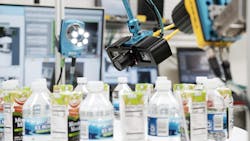Equipment obsolescence, component obsolescence, personnel repair expertise—these are all reasons to replace parts of your vision/imaging system, and they are good ones. There are end users, however, who would rather stay with the equipment they have for as long as possible, even if they cannot source the components anymore. At that point, they may choose to solicit the services of American Industrial (Warren, MI, USA; www.americanindustrialinc.com), a company founded on industrial electronics repair that in 2018 diversified into machine vision camera repair upon learning about the need in the marketplace.
American Industrial History
The idea that became American Industrial all started at lunch one day in 1988, according to Bob Gordon, Chairman of the Board. “I was out with a customer from General Motors,” he says. “I was in the bearing and power transmission business for many years. I was having lunch with a person from GM who I had gotten to know very well. I wanted to start my own business, so I just asked him if he had any ideas for what I could do for his plant.” The GM employee filled out a napkin, front and back, with ideas, one of which was LVDT transducer repair. “I did some research and found someone who did that [repair], incorporated the company, and set up a little business in my basement,” says Gordon. So, as a company, he says, it has been reacting to the needs of the automotive industry. “That’s been the driver behind all the niches that we’ve gotten into,” he adds. “You know the old axiom: find a need and fill it.”
In 1990, the company expanded into encoder repair and experienced growth within this niche. In 1994, the company further expanded in the precision and metrology sector by adding Marposs gauge repair. Through the company’s encoder repair business, Gordon found out that one customer had a significant amount of Marposs gauges in its facility and were in need of repair support. “As a company we are always looking for ways we can add value to our cutomers and solve problems,” Gordon says. “To address their issue, we hired an experienced technician and worked with the plant to alleviate the service issues they were experiencing that were causing repeated down-time for them.”
In 1996, the company expanded into data gauges, again driven by problems at the GM plant. The company set itself to repair the gauges, lowered the cost, shortened the delivery time, and according to Gordon, “made a real happy customer out of them.”
In 1997 the company expanded into industrial electronic control repair, covering PLCs, monitors, encoders, drives, HMIs, and power supplies. In 2003, the company moved into variable frequency drives and servo motors. In the next few years, it also expanded into robotics and CNC controls, to the point that it was basically covering everything that goes through the electronics part of a business. It started to move into vision in 2010 when it began repairing automated guided vehicle (AVG) sensors and safety scanners, but it was 2018 when it actually started repairing vision system cameras. “We were already doing light curtains and AVGs,” says Gordon, “But we weren’t doing these high-tech cameras and barcode scanners at the time.”
It was when American Industrial was exhibiting at the Advanced Manufacturing Expo that someone from the pharmaceutical industry brought a small camera to the booth and asked if the company could repair it. “I looked it and said what is it,” says Gordon. The representative explained, and Gordon said that American Industrial could repair it, but asked, “Can I take it with me and do the R&D on it? We don’t have the capability now, but we develop new capabilities every day.” The pharmaceutical representative agreed.
The case background is that the pharmaceutical manufacturer had four of the cameras that worked in unison, but if one went out, the whole system went out. The camera manufacturer wanted the company to upgrade because it did not fix the cameras anymore. Gordon brought it back and gave it to his lead engineer, who set up all the tests and who, according to Gordon, is “the brains behind this.” After the repair, American Industrial started advertising the service, and the business grew over a period of time. And, this segment of its business has become very important. “It’s what is helping us diversify out of automotive right now,” says American Industrial’s sales director. “It is probably the single largest focus for us on the sales side.”
Daniel Gordon, President, adds, “The high development over the last three or four years has been on the inspection cameras and high-speed barcode cameras. That type of vision system is more specialized. The other type of scanning devices—the proximity scanners, the safety scanners, the cameras that are on the front of AGVs—we’ve been doing them for 10 to 20 years.”
The Repair Process
American Industrial will not repair a camera if it cannot fully test it. According to the company’s lead engineer, the first thing it does with any camera is OEM documentation, OEM software, OEM cabling, any connection modules, or anything needed to fully functionally test that unit. American Industrial will test every aspect of it including the I/O. If it has a certain scan range, it will go by the OEM manual specs. For every repair, American Industrial ensures it can address those items before the company says it can repair it or quote it.
According to the company’s sales director, all repairs start with a failed unit coming through the door from a customer. “We’re a repair company,” he says. “We are not in the business to sell new or sell refurbished. We don’t advertise or try to solicit new sales or refurbished sales. It’s not a business model we are developing at all. We don’t build the system test and then go to find the broken ones. We really are reacting to the customer’s and market’s needs.” Some of it happens with obsolescence, he explains, citing an example where American Industrial quoted hundreds of units at one time because a certain model number were obsolete, but a line had been decommissioned and a customer wanted to use the same system on a new line when it installed it.
According to the company’s lead engineer, the first step in a camera repair at American Industrial is to make sure technicians can connect to the camera and talk to it through the software. He explains, “In the real world, these cameras are constantly scanning or inspecting parts moving on a conveyor—parts moving by and being triggered to scan them or being triggered to inspect them. So, we took it upon ourselves to simulate that.” The company has a conveyor belt as well as a rotary table and the triggers that will trigger the camera to either snap a picture or scan an item when a part comes up.
The company is currently set up for 16 manufacturers—inspection cameras, barcode cameras, etc. Whenever it gets a new camera in from a customer, the first step is to make sure American Industrial can get documentation on the camera.
Many of the cameras American Industrial receives for repair have experienced physical or environmental damage, for example. The cameras get too hot, the lenses go bad, or there is contamination. Obsolescence is another reason for repairs because the customer can’t get the repair made anywhere else and does not want to buy the new version.
Bob Gordon explains that once repaired, the camera has a one-year in-service, all-inclusive, bumper-to-bumper warranty. “We test all components,” he says. “We put it through a full system test. It’s one-year service with a one-year shelf life. What that means is they have one year to send it back. After the one year is up, the warranty is over if they haven’t sent it back for repair. If they sent it back within the first year or install it into production, then they get another year added onto whatever it was.” Daniel Gordon adds, “They can keep it in their inventory for up to a year before they install it in their environment. The warranty doesn’t start until they put it in their equipment.”
American Industrial has an online portal customers can use to activate their warranty, research how and why cameras have failed by model number and frequency, and more. The system is called OASIS, which stands for Online Access System to Immediate Status. The customer can also check on open orders, closed orders, approve orders, view order history, see repair reports, and see if it has sent back a Warranty In-service Notification (WIN) card.
Although most of its volume is from North America, Daniel Gordon says that the company has received items from other countries and that American Industrial has no issues processing from anywhere. “We have no limits,” adds Bob Gordon. “We will repair and ship anywhere in the world.” The company’s sales director explains that American Industrial is excited about the camera repair business internationally because it’s easier to ship small cameras than large drives around the world. “As long as the customer can deal with duties and the like, it’s pretty easy,” he says.
Savings and Value
With American Industrial’s vision camera repair business, as well as it’s other businesses, there are savings to be able to use repaired/refurbished equipment that has been tested to how the customer is using it. According to the company’s sales dierctor, the company is optimisitc that once logistics is back, and supply chains are robust again, that the company will have convinced customers that repaired product brings tremendous value to their manufacturing environments.
Most important though, Bob Gordon emphasizes, is that the company does not ship a repair unless it can fully test the item, including the I/O, communications, and overall function using OEM software and external components. “We know they’re working when they’re going back out,” he concludes.
About the Author
Chris Mc Loone
Editor in Chief
Former Editor in Chief Chris Mc Loone joined the Vision Systems Design team as editor in chief in 2021. Chris has been in B2B media for over 25 years. During his tenure at VSD, he covered machine vision and imaging from numerous angles, including application stories, technology trends, industry news, market updates, and new products.

